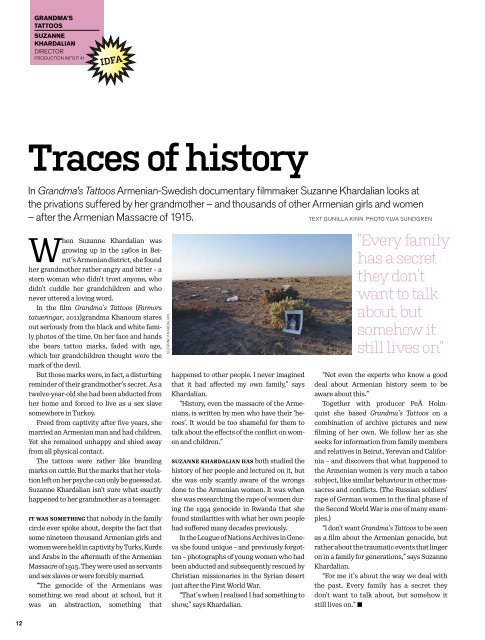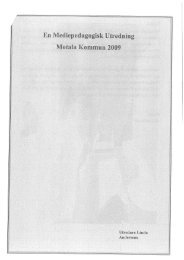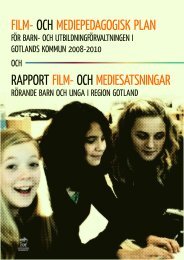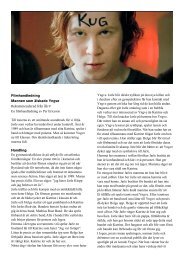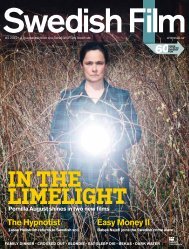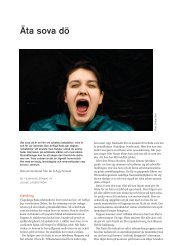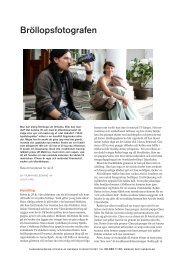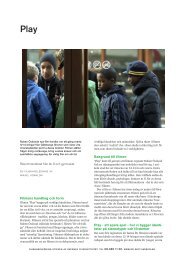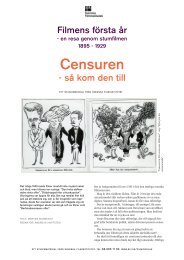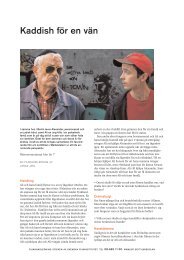Love and murder - Swedish Film Institute
Love and murder - Swedish Film Institute
Love and murder - Swedish Film Institute
You also want an ePaper? Increase the reach of your titles
YUMPU automatically turns print PDFs into web optimized ePapers that Google loves.
12<br />
Gr<strong>and</strong>ma’s<br />
tattoos<br />
suzanne<br />
kHardalian<br />
direcTor<br />
producTion info p. 41<br />
IDFA<br />
Traces of history<br />
in Gr<strong>and</strong>ma’s Tattoos armenian-swedish documentary filmmaker suzanne khardalian looks at<br />
the privations suffered by her gr<strong>and</strong>mother – <strong>and</strong> thous<strong>and</strong>s of other armenian girls <strong>and</strong> women<br />
– after the armenian massacre of 1915. TexT Gunilla kinn phoTo YlVa sundGren<br />
When Suzanne Khardalian was<br />
growing up in the 1960s in Beirut’s<br />
Armenian district, she found<br />
her gr<strong>and</strong>mother rather angry <strong>and</strong> bitter – a<br />
stern woman who didn’t trust anyone, who<br />
didn’t cuddle her gr<strong>and</strong>children <strong>and</strong> who<br />
never uttered a loving word.<br />
In the film Gr<strong>and</strong>ma’s Tattoos (Farmors<br />
tatueringar, 2011)gr<strong>and</strong>ma Khanoum stares<br />
out seriously from the black <strong>and</strong> white family<br />
photos of the time. On her face <strong>and</strong> h<strong>and</strong>s<br />
she bears tattoo marks, faded with age,<br />
which her gr<strong>and</strong>children thought were the<br />
mark of the devil.<br />
But those marks were, in fact, a disturbing<br />
reminder of their gr<strong>and</strong>mother’s secret. As a<br />
twelve-year-old she had been abducted from<br />
her home <strong>and</strong> forced to live as a sex slave<br />
somewhere in Turkey.<br />
Freed from captivity after five years, she<br />
married an Armenian man <strong>and</strong> had children.<br />
Yet she remained unhappy <strong>and</strong> shied away<br />
from all physical contact.<br />
The tattoos were rather like br<strong>and</strong>ing<br />
marks on cattle. But the marks that her violation<br />
left on her psyche can only be guessed at.<br />
Suzanne Khardalian isn’t sure what exactly<br />
happened to her gr<strong>and</strong>mother as a teenager.<br />
It wAs somethIng that nobody in the family<br />
circle ever spoke about, despite the fact that<br />
some nineteen thous<strong>and</strong> Armenian girls <strong>and</strong><br />
women were held in captivity by Turks, Kurds<br />
<strong>and</strong> Arabs in the aftermath of the Armenian<br />
Massacre of 1915. They were used as servants<br />
<strong>and</strong> sex slaves or were forcibly married.<br />
“The genocide of the Armenians was<br />
something we read about at school, but it<br />
was an abstraction, something that<br />
suZanne khardalian<br />
happened to other people. I never imagined<br />
that it had affected my own family,” says<br />
Khardalian.<br />
“History, even the massacre of the Armenians,<br />
is written by men who have their ‘heroes’.<br />
It would be too shameful for them to<br />
talk about the effects of the conflict on women<br />
<strong>and</strong> children.”<br />
suzAnne KhArdAlIAn hAs both studied the<br />
history of her people <strong>and</strong> lectured on it, but<br />
she was only scantly aware of the wrongs<br />
done to the Armenian women. It was when<br />
she was researching the rape of women during<br />
the 1994 genocide in Rw<strong>and</strong>a that she<br />
found similarities with what her own people<br />
had suffered many decades previously.<br />
In the League of Nations Archives in Geneva<br />
she found unique – <strong>and</strong> previously forgotten<br />
– photographs of young women who had<br />
been abducted <strong>and</strong> subsequently rescued by<br />
Christian missionaries in the Syrian desert<br />
just after the First World War.<br />
“That’s when I realised I had something to<br />
show,” says Khardalian.<br />
“Every family<br />
has a secret<br />
they don’t<br />
want to talk<br />
about, but<br />
somehow it<br />
still lives on”<br />
“Not even the experts who know a good<br />
deal about Armenian history seem to be<br />
aware about this.”<br />
Together with producer PeÅ Holmquist<br />
she based Gr<strong>and</strong>ma’s Tattoos on a<br />
combination of archive pictures <strong>and</strong> new<br />
filming of her own. We follow her as she<br />
seeks for information from family members<br />
<strong>and</strong> relatives in Beirut, Yerevan <strong>and</strong> California<br />
– <strong>and</strong> discovers that what happened to<br />
the Armenian women is very much a taboo<br />
subject, like similar behaviour in other massacres<br />
<strong>and</strong> conflicts. (The Russian soldiers’<br />
rape of German women in the final phase of<br />
the Second World War is one of many examples.)<br />
“I don’t want Gr<strong>and</strong>ma’s Tattoos to be seen<br />
as a film about the Armenian genocide, but<br />
rather about the traumatic events that linger<br />
on in a family for generations,” says Suzanne<br />
Khardalian.<br />
“For me it’s about the way we deal with<br />
the past. Every family has a secret they<br />
don’t want to talk about, but somehow it<br />
still lives on.” n


